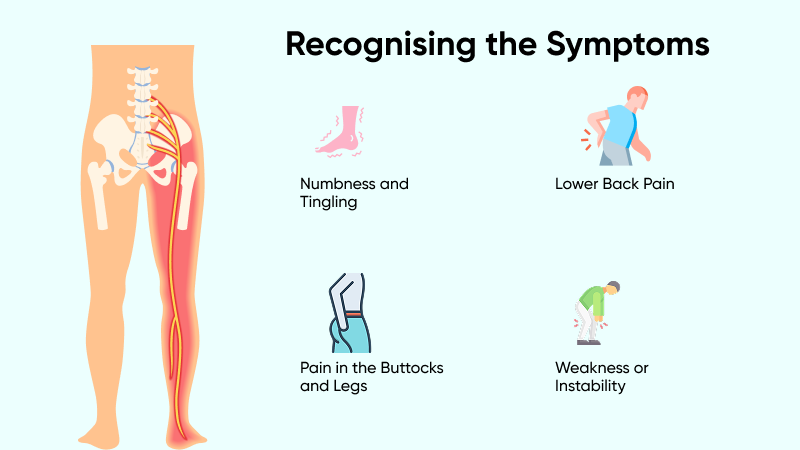Lower back pain that travels down your leg can be more than just a sprain. It could be sciatica. While many people have heard of the condition, very few truly understand it.
At Epione Pain Management, we meet several patients every week who come to us after months of struggling with radiating leg pain. This blog is for them and you, if you’re in the same boat. Let’s break it down in simple words.
What is Sciatica?
Sciatica is not a condition in itself, but a symptom of something pressing or irritating the sciatic nerve. This nerve is the largest in your body, running from your lower back, through the buttocks, and down each leg. When it’s inflamed or compressed, it causes pain along this path. Most people experience it only on one side.
This pain can vary. Some describe it as a dull ache. Others say it feels like a sharp, stabbing or electric-like sensation. It can come with numbness, tingling, or even weakness in the leg.
Root Causes of Sciatica
Sciatica pain often starts because of issues in the lower spine or muscles nearby. These are the most common sciatica pain causes we see:
- Piriformis Syndrome: The piriformis muscle, located deep in the buttock, can sometimes spasm and press against the sciatic nerve. This usually happens due to prolonged sitting, uneven posture, or injury.
- Osteoarthritis: This condition wears down the joints over time. It may cause bone overgrowth, which can put pressure on the nerve and lead to chronic pain.
- Spinal Stenosis: Here, the spinal canal becomes narrow. This puts pressure on the nerves, including the sciatic nerve, especially in older adults.
- Tumors or Infections: Though rare, abnormal growths or infections around the spine can compress the nerve and lead to sciatica symptoms.
- Spondylolisthesis: This occurs when one vertebra slips forward over the one below it. The slipped bone may press against the nerve root, causing pain, especially when walking or bending.
If you’re wondering what causes sciatica, it often begins with one of these underlying structural issues. Sometimes, even a minor movement can trigger it if the nerve is already under pressure.
Recognising the Symptoms

Sciatica symptoms may feel different for each person. Still, most patients experience at least one of the signs below. Understanding sciatica symptoms and causes can help you seek early help.
- Numbness and Tingling: A common sign of nerve involvement. You might feel pins and needles or complete numbness in your leg or foot.
- Lower Back Pain: This is usually the starting point. The pain may feel mild at first, but can worsen with walking, sitting, or even coughing.
- Pain in the Buttocks and Legs: Often one-sided, the pain travels down from the hip to the thigh, calf, or even foot. It may feel worse at night or after standing for long periods.
- Weakness or Instability: You may notice that the affected leg feels weak, heavy, or hard to move. This could signal that the nerve is severely affected.
These symptoms may be signs of what causes sciatica pain to persist or worsen over time. Don’t ignore them, especially if you’re noticing changes in balance or movement.
Effective Non-Surgical Treatments for Sciatica
At Epione, we believe in treating the root cause, without rushing into surgery. Here’s how we help you manage sciatica with advanced, safe, and evidence-backed care:
- Epidural Injections: This is one of our most effective options for reducing inflammation around the sciatic nerve. Done under expert guidance, it provides long-term relief for many.
- Nerve Blocks: This involves injecting local anaesthesia near the affected nerve root to block pain signals. It’s quick, safe, and often gives instant relief.
- Medication & Physical Therapy: We may use short-term pain relief through anti-inflammatory drugs, muscle relaxants, or nerve-calming medicines. These are paired with back and core strengthening exercises, designed by our in-house experts.
- Lifestyle and Posture Correction: Most people don’t realise how daily habits like slouching or long hours of sitting affect their spine. We guide you with posture tips, exercises, and small changes that go a long way.
These treatments work especially well for patients seeking sciatica pain treatment in Chennai without going under the knife. Our goal is to improve your quality of life, not just reduce the pain temporarily.
Conclusion
Sciatica can be painful, but it’s also manageable. If you’ve been searching for answers about what causes sciatica, or struggling with leg and back pain, we’re here to help.
At Epione, your trusted Chennai pain management centre, we offer expert, non-surgical care tailored to your needs. Book your consultation today and take the first step toward living pain-free.

